Ergonomics: why and how should we think about it? Poor posture when working at a computer screen can lead to aches and pains that make employees less effective at work, or even lead to absenteeism. Today, there is also concern about the increased cardiovascular risk for sedentary workers. New ways of organising work can increase these risks: open space, teleworking, flex office, coworking spaces. So how can you offer your employees a better workspace for a better quality of life at work? Murielle Monge, occupational physician and trainer specialising in ergonomics, gives us an overview.

The ergonomics of the workstation play an important role essential to the well-being and performance of our employees. As human resources professionals, you have a key role to play in raising awareness, preventing risks and optimising working conditions. So how do you go about it?
Why is ergonomics crucial?
In other words, what are the risks of poor workstation ergonomics? Inadequate posture at the workplace can lead not only to musculoskeletal disorders (MSDs) but also to cardiovascular pathologies linked to a sedentary lifestyle.
Examples:
TMS : joint pain, lower back pain, tense hands, often caused by repetitive movements or prolonged static posture.
Visual fatigue : prolonged exposure to screens, inappropriate light contrasts.
Cardiovascular and metabolic risks : the direct consequences of a prolonged sedentary lifestyle.
Stress and mental workload : aggravated by poorly organised spaces and constant interruptions.
Key figures :
MSDs represent 87 % occupational illnesses.
40 % of employees complain of back pain.
A sedentary lifestyle increases 30 % the risk of cardiovascular disease.
What is a sedentary posture?
At work, this is a sitting posture, maintained over time and associated with a very low energy expenditure.
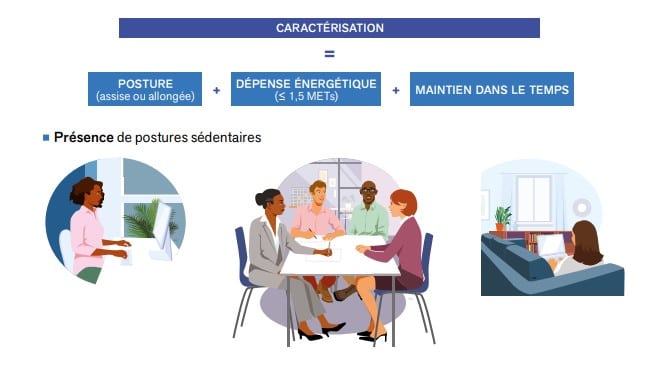
Ergonomic measures are therefore essential to protect employee health and improve productivity. The occupational health and prevention service (occupational medicine) advises employers and employees on what needs to be done.
Fitting out workstations efficiently
The standard workstation consists of six key elements.
Here's how to make the most of it:
1/ The seat
- Adapting the seat to the employee's stature
- Provide instructions on how to adjust them: very often, seats are extremely flexible, but employees are unaware of this.
- Provide a footrest for small statures
2/ The screen
- Adjust its height to avoid neck pain
- Position the screen perpendicular to windows to limit reflections
3/ Keyboard and mouse
- Choosing a mouse to suit the size of your hand
- Place paper documents between the keyboard and the screen
4/ Peripheral elements
- Keep tools (telephone, notebooks) close by to limit awkward postures for the shoulders
5/ The lighting environment
- Choose soft LED lighting
- Avoid areas with unbalanced light levels
INRS - ED 924 - Display screens, health and ergonomics
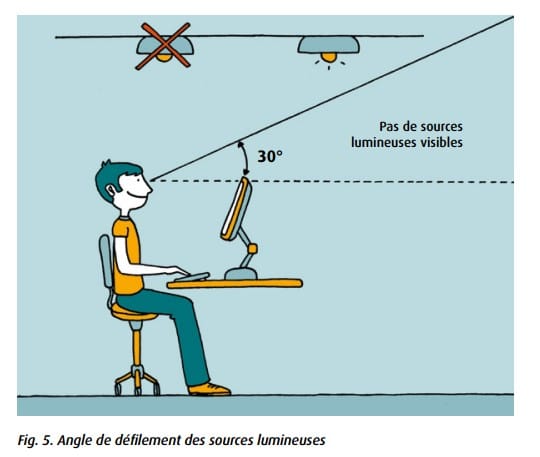
6/ The sound environment
- Keep quiet areas away from noisy areas (cafeteria, entrances)
- Installing noise barriers
[Note]
Many aspects of the job depend on the employee's interpersonal skills. This is why we HR has an important role to play in raising awareness. By themselves, via the general services and thanks to the prevention referents.
Teleworking: a few specifics
Four fundamental areas must be mastered if you are to navigate serenely in this environment:
Organisation of work
Avoid assembly-line meetings, and plan a 10-minute break after a 50-minute meeting.
Posture
Alternate between sitting and standing positions with a suitable desk (a standing desk in the kitchen is a good alternative).
Visual pause
Don't position the screen against a wall - you need to be able to look away.
Flex office and coworking: adapting ergonomics
In these shared spaces, employees must take the time to set up correctly every time. This means systematically adjusting the seat and adapting the height of the screen to their stature.
When you change cars, you start by adjusting your seat and mirrors before you drive off. It's the same in a flex office!
You also need :
- Provide confidential areas to reduce mental workload: in sufficient numbers and bookable online
- Define codes of conduct in flex office, put up posters, regularly remind people of the rules
[Also read]
Work organisation: a pillar of ergonomics
It's not something you think about at first glance. Yet the way work is organised has a direct impact on ergonomics.
Firstly, employees must have the freedom to take breaks when they want to. Introducing regular breaks can also create a reflex among those who find it hardest to let go of the screen. To limit postural fatigue and cardiovascular risks, it is also essential to get up every 30 minutes.
Trick : Encourage stand-up mini-meetings and physical exchanges rather than everything by e-mail or video.
Next, it is essential to limit organisational stress.
To achieve this, HR can promote good management practices.
Example : Distribute tasks fairly, allow time off between meetings.
A typical case to avoid: an urgent request at 5.30 p.m. means running the risk of the employee giving up the right posture to finish before leaving.
Finally, it is their responsibility toidentify signals of overloade: lateness, fatigue, absenteeism.
HR also has a role to play in hybrid management. It's all about supporting managers and employees in the practice of teleworking. Define priorities clearly and support teams to reduce the feeling of excessive control.
A few best practices:
- Create tutorials for digital tools
- Set up rapid IT support (FAQs, troubleshooting)
- Supporting new arrivals in a sometimes empty environment (partial teleworking by managers and mentors)
[Also read]
Training and raising awareness among employees: prevention is an essential lever
Primary prevention allows action to be taken before pain appears.
To do this:
- Make a workstation diagnostics with the help of prevention specialists or ergonomists
- Raise employee awareness of settings (demonstrations, checklists)
- Plan ahead tailored training
[Training in action]
The practice of Dr Murielle Monge
During a training course I ran for a medical analysis laboratory, the employees worked on their own "cases". On a daily basis, they validate a lot of data on a computer. Before the training, I ask them to send me photos of their workstations. Then, they have to list the risk factors (MSD, sedentary lifestyle, etc.) and define the points to be improved. This pragmatic approach maximises the impact of the training.
Take action to prevent the risks of sedentary postures!
Here are some examples of visuals for prevention:
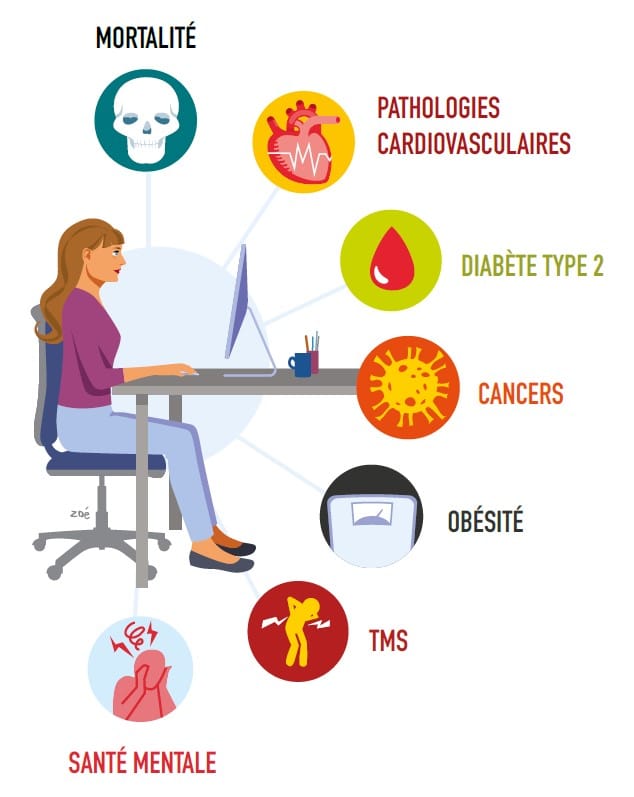
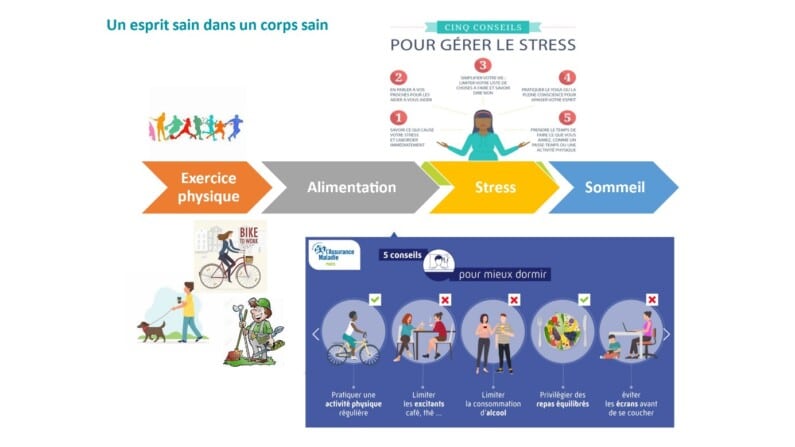
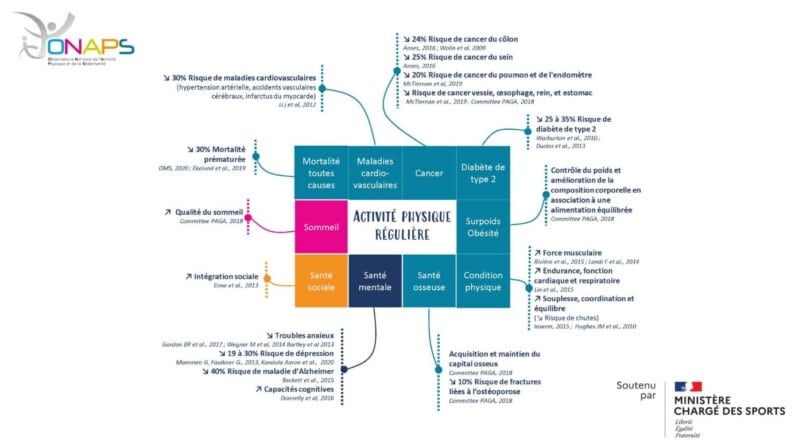
Ergonomics: the need to work with stakeholders
In the workplace, a number of players contribute to effective ergonomics. HR works hand in hand with :
- the occupational health and prevention service (formerly the occupational medicine service), which advises employers and supports employees
- health prevention officers (in companies with more than 50 employees)
- general services, which maintain equipment (seats, lighting, etc.)
- and managers in identifying needs and adapting workloads
In conclusion, ergonomics in the workplace is based on three fundamental principles. Firstly, adapted equipment: seats, sit-stand desks, ergonomic mice, etc. Secondly, optimised organisation, including regular breaks and workload management. Finally, ongoing training to prevent risks. But good ergonomics is not just a matter of comfort, it's a winning strategy for employee health, motivation and performance. As HR managers, you are in the best position to instil this dynamic and make ergonomics a key asset for your company. So don't forget to remind your teams: getting comfortable and moving regularly are the two pillars of a healthy working environment.





